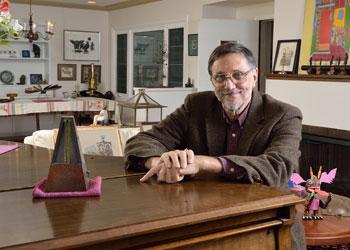The Art & Science of Psychology
Knowing that many young people today have not been so fortunate, including many students at MSU, Lauren recently established six endowments at MSU to help support the arts.
February 26, 2014
Lauren Harris, professor of psychology at Michigan State University, is in the living room of his East Lansing home, standingby the piano that he inherited from his mother. On the walls and shelves behind him—and even, temporarily, on the couch—are works of art in a variety of styles, colors, shapes, and sizes, including many by local artists and students.
“I have loved the arts all my life,” says Lauren, who started piano lessons at age seven and played the cello in high school. He credits his parents for his appreciation of the arts; his mother, Belle, was a pianist, and his father, Julius, was a teacher, a lover of writing and literature, and, just to break the stereotype, a multi-talented athlete and coach.
As children, Lauren and his sister, Eleanor, also were lucky to attend public schools at a time when the arts were deemed to be worthy of support, and to grow up in Chicago, with its great symphony orchestra, architecture, galleries and museums, art festivals, and other cultural institutions. Their synagogue also had a renowned music program as well as a celebrated cantor with a voice made for grand opera. “All these were precious gifts, which have enriched my life,” says Lauren.
Knowing that many young people today have not been so fortunate, including many students at MSU, Lauren recently established six endowments at MSU to help support the arts. All are planned gifts that he has already begun funding with yearly cash donations that take advantage of the 2011 IRA charitable rollover. Over time, Lauren will grow each endowment with additional gifts.
Two of the endowments, one for the College of Arts and Letters and another for the College of Music, are named after Lauren’s parents and will help fund these colleges’ Visiting Artists programs, which bring musicians, dancers, and other artists to campus for performances, master classes, residencies, and other meetings with students and the community. This fall, the College of Music endowment will support a residency by the prominent concert pianist Russell Sherman. In spring 2012, Lauren sponsored a residency by dancer and choreographer Billy Bell (through the MSU Residential College in the Arts and Humanities). It included a visit to Lauren’s undergraduate class in developmental psychology where Bell told the students about how he became interested in dance and how much it has meant to him in his life.
Two other endowments will support educational programs—including the arts—for the MSU Hillel Jewish Student Center and the Jewish Studies Program in the College of Arts and Letters. An endowment for the MSU Libraries will include support for the acquisition and display of works of art by MSU students.
The last endowment, in the Department of Psychology, is to help in efforts to bridge what the English scientist and writer C.P. Snow famously called “The Two Cultures,” the gulf between the arts and the sciences. “Some believe they can’t be brought together. Others think they can, and I’m one of them,” Lauren says.
He says this could be accomplished through the joint participation of artists and scientists in lectures, demonstrations, performances, and discussions, “in the course of which we can address a variety of questions, some pondered mostly by artists, others by scientists, and still others by both, each in their own way and often with their own insights and answers.”
Lauren continues, “I’ve been to a number of conferences where psychologists and other behavioral scientists present their research on the arts, but I always thought something was missing. I wanted to hear from the artists themselves.”
He hopes that through these meetings and, indeed, through all the endowments, more ways can be found to foster, sustain, and deepen interest in and participation in the arts by people of all ages, but especially the young, and “not just through appearances by artists in the usual formal settings where, alas, so many students evidently fear to tread, but through outreach to students in everyday places on campus. The arts are universal: let them ‘break out’ everywhere!”




